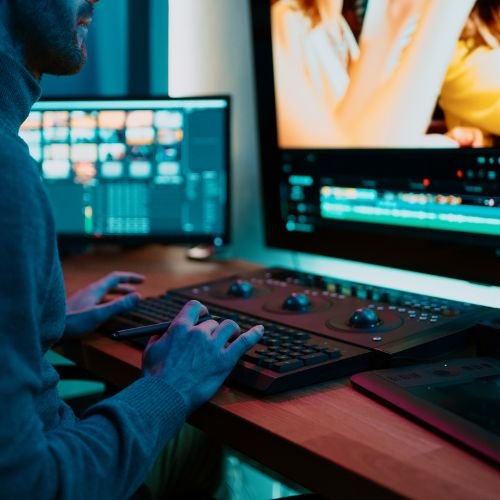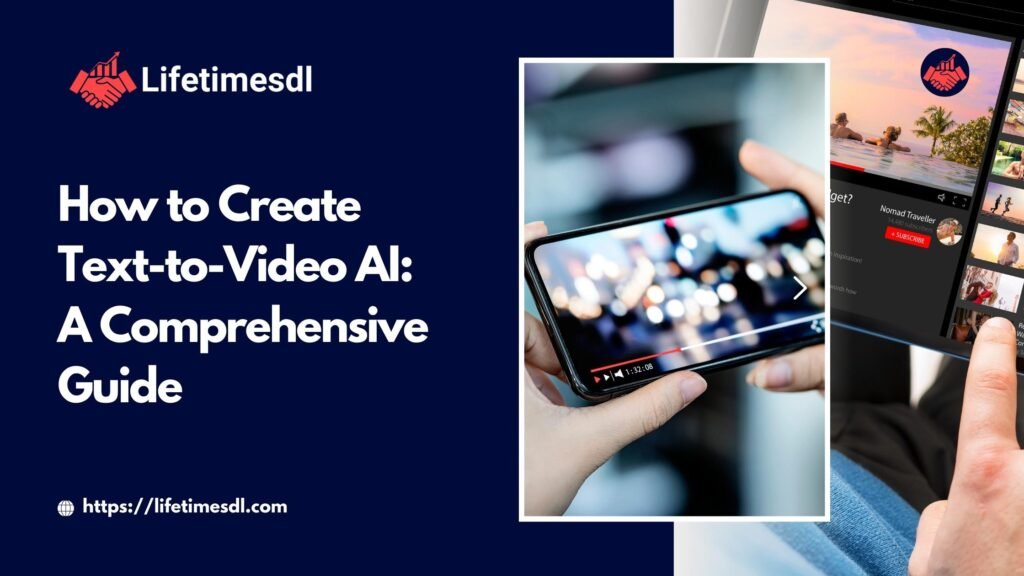To create text-to-video AI, follow essential steps including data collection, model selection, training, refining, and integration, ensuring the AI generates coherent, high-quality video from text inputs.
In today’s digital age, video content reigns supreme across social media platforms, educational websites, and marketing campaigns. With the advent of artificial intelligence, transforming textual content into engaging videos has become a reality. How to make text to video AI is a question that many developers and content creators are asking as they seek to automate and enhance their content production processes. In this comprehensive guide, we will delve into the intricacies of creating your own text-to-video AI, exploring the key components, steps involved, and best practices to ensure success.
What Is Text-to-Video AI?

Text-to-video AI is a technology that converts written text into a dynamic video format. It leverages advanced algorithms in natural language processing (NLP), computer vision, and audio synthesis to generate videos that can include images, animations, voiceovers, and background music corresponding to the input text. This technology is revolutionizing content creation by making it more accessible and efficient.
At its core, text-to-video AI analyzes the semantic content of the text to determine the most appropriate visual and auditory elements. It selects relevant stock footage, generates voiceovers with natural-sounding speech, and synchronizes these components to produce a cohesive video. Understanding how to make text to video AI requires a grasp of these underlying technologies and how they interact.
Why Create Your Own Text-to-Video AI?
Creating your own text-to-video AI offers numerous advantages. It allows for customization tailored to specific needs, such as niche industry requirements or unique branding elements. By developing your own system, you have control over the data inputs, processing methods, and output styles, which can lead to higher-quality content that aligns perfectly with your objectives.
Moreover, having an in-house text-to-video AI can significantly reduce content production time and costs. It automates repetitive tasks, freeing up resources for more strategic initiatives. For businesses, this means faster turnaround times for marketing materials and the ability to produce large volumes of content without a proportional increase in expenditure.
Key Components of Text-to-Video AI
Building a text-to-video AI involves integrating several complex components. Below are the essential elements you need to consider:
Natural Language Processing (NLP)
NLP is the foundation of text-to-video AI. It enables the system to understand and interpret the input text. The NLP module analyzes the grammar, semantics, and context to extract meaningful information, which is crucial for selecting appropriate visual and auditory content.
Video Generation Algorithms
These algorithms are responsible for assembling the video components. They match textual elements with relevant images or clips, arrange scenes logically, and apply transitions and effects. Advanced algorithms can even generate animations or graphics dynamically based on the text.
Voiceover and Speech Synthesis
Voiceovers add a personal touch to videos. Speech synthesis technologies convert text into spoken words using synthetic voices. Modern systems use deep learning models to produce natural-sounding speech with appropriate intonation and emotion, enhancing the viewer’s engagement.
Stock Media Integration
Access to a vast library of stock images, videos, and audio clips is essential. Integration with stock media repositories allows the AI to select from a wide range of content, ensuring that the visual elements are relevant and high-quality.
Step-by-Step Guide on How to Make Text-to-Video AI

Creating a text-to-video AI is a complex process, but breaking it down into manageable steps can simplify the task. Here’s a detailed guide:
1. Define Your Objectives
Before you begin, clearly define what you aim to achieve with your text-to-video AI. Consider the following:
- Target Audience: Who will be viewing the videos?
- Content Type: Educational, promotional, entertainment, etc.
- Platforms: Will the videos be for YouTube, Instagram, TikTok, or other platforms?
- Customization Needs: Any specific branding or stylistic requirements?
Having a clear objective guides the development process and ensures that the end product meets your needs.
2. Gather Required Tools and Resources
Assemble all the tools and resources you’ll need:
- Programming Languages: Python is commonly used for AI development.
- Frameworks: TensorFlow or PyTorch for machine learning models.
- APIs: Access to NLP libraries like NLTK or spaCy.
- Stock Media Libraries: Integration with platforms like Shutterstock or Pixabay.
- Cloud Services: For storage and processing power if necessary.
3. Develop the NLP Module
The NLP module interprets the input text. Steps include:
- Text Preprocessing: Tokenization, stemming, and lemmatization.
- Semantic Analysis: Understanding context and meaning.
- Keyword Extraction: Identifying key themes and concepts.
Use pre-trained models or train your own using relevant datasets to enhance accuracy.
4. Implement Video Generation
Develop algorithms that:
- Map Text to Visuals: Associate keywords with images or clips.
- Scene Sequencing: Arrange visuals in a logical flow.
- Apply Transitions and Effects: Smooth transitions enhance professionalism.
Consider using computer vision techniques to improve the selection of visuals.
5. Integrate Voiceover Capabilities
Add speech synthesis to narrate the text:
- Select Speech Engines: Use platforms like Google Text-to-Speech or Amazon Polly.
- Customize Voices: Choose voices that match your brand’s tone.
- Sync Audio with Visuals: Ensure that the voiceover aligns with the visual content.
6. Test and Iterate
Testing is crucial to refine your AI:
- Functional Testing: Ensure all components work together seamlessly.
- User Feedback: Gather input from real users to identify areas for improvement.
- Iterative Development: Continuously refine algorithms based on feedback.
Best Practices for Developing Text-to-Video AI
To ensure the success of your text-to-video AI, follow these best practices:
- Data Quality: Use high-quality datasets for training NLP and speech models.
- User Experience: Prioritize ease of use, especially if others will interact with your AI.
- Scalability: Design your system to handle increasing volumes of content.
- Ethical Considerations: Be mindful of copyright laws when using stock media and ensure that your AI does not produce biased or inappropriate content.
- Performance Optimization: Optimize algorithms for speed without compromising quality.
FAQs About Create Text-to-Video AI
1. What programming languages are best for creating text-to-video AI?
Python is the most popular language due to its extensive libraries and frameworks for AI development. It supports NLP, machine learning, and computer vision, making it ideal for building text-to-video AI systems.
2. Can I use open-source tools to build my text-to-video AI?
Yes, many open-source tools and libraries are available for NLP, speech synthesis, and video processing. Utilizing these resources can accelerate development and reduce costs.
3. How do I ensure the voiceovers sound natural?
Use advanced speech synthesis models that employ deep learning techniques. Fine-tune the models with high-quality voice data and adjust parameters to achieve natural intonation and emotion.
4. Is it legal to use stock media in my AI-generated videos?
You must have the proper licenses to use stock media. Integrate with platforms that offer API access and ensure compliance with their terms of service to avoid legal issues.
5. How long does it take to develop a text-to-video AI?
The development time varies depending on the complexity of your project, resources, and expertise. It could range from a few months to over a year for more sophisticated systems.
6. Can text-to-video AI be used for languages other than English?
Yes, by training your NLP and speech models on data in the target language, you can create a text-to-video AI that supports multiple languages.
7. How do I handle updates and maintenance?
Establish a maintenance plan that includes regular updates to algorithms, security patches, and system optimizations. Stay informed about advancements in AI technologies to keep your system up-to-date.
8. What are the costs involved in developing text-to-video AI?
Costs include development time, computational resources, licensing fees for stock media and APIs, and ongoing maintenance. Budgeting for these expenses is essential for successful project completion.
Conclusion
Creating your own text-to-video AI is an ambitious but rewarding endeavor. By understanding the key components and following a structured development process, you can build a system that automates video creation, enhances content quality, and aligns with your specific objectives. Remember to prioritize data quality, user experience, and ethical considerations throughout the development process. With this comprehensive guide on how to make text to video AI, you’re well on your way to revolutionizing your content creation strategy.
Key Components and Tools for Text-to-Video AI Development
| Component | Tools/Technologies |
|---|---|
| Natural Language Processing (NLP) | NLTK, spaCy, GPT models |
| Video Generation Algorithms | OpenCV, FFmpeg, custom Python scripts |
| Voiceover and Speech Synthesis | Google Text-to-Speech, Amazon Polly |
| Stock Media Integration | APIs from Shutterstock, Pixabay |
| Programming Languages | Python, JavaScript |
| Machine Learning Frameworks | TensorFlow, PyTorch |
| Cloud Services | AWS, Google Cloud Platform, Microsoft Azure |




